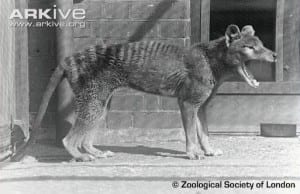Happy 81st Thylacine Day: Thylacines were lucky to last as long as they did
By Jack Ashby, on 7 September 2017
81 years ago today – the 7th September 1936 – the last known thylacine died, committing its species, indeed its entire family, to extinction.

The last known living thylacine, 1933. (Image in the public domain, photographer unknown)
It was locked out of the indoor section of its enclosure at a zoo in Hobart, and in the overnight chill of the Tasmanian winter it died of exposure. All that now remains of the then largest marsupial carnivore is in museums.
In a sense it was lucky. (more…)
 Close
Close








